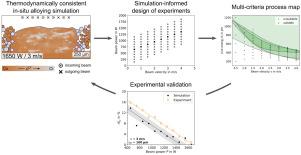Simulation-driven development of in-situ alloying Cu-25Cr by electron beam powder bed fusion
IF 11.1
1区 工程技术
Q1 ENGINEERING, MANUFACTURING
引用次数: 0
Abstract
Based on its excellent electrical conductivity in combination with a high arc erosion resistance and withstand voltage, the alloy Cu-25Cr is widely applied as a contact material for high-power vacuum interrupters. The utilization of the electron beam powder bed fusion (PBF-EB) method for the processing of this material offers the major advantage of producing extremely fine Cr precipitates due to the rapid solidification of the melt pool, which can further improve the application-specific properties significantly.
In this work, the in-situ alloying of Cu-25Cr from an elemental powder blend via PBF-EB was investigated numerically and experimentally, which resulted in the development of a first process window for the production of dense and well-mixed samples. In doing so, the number of necessary experimental tests could be greatly reduced by using numerical predictions for the definition of the design of experiments. In addition, simulations were used to gain an understanding of the formation mechanism of characteristic defects. These calculations were carried out using an in-house developed software, which was successfully validated against the experimental results.
As part of the experimental tests, it was demonstrated that the powder mixture does not segregate during its application on the start plate, which forms the basis for the reliable production of components with a consistent composition. At a build temperature of approximately 600 °C, it was then possible to produce cuboid samples with a porosity of smaller than 0.1% and a fraction of unmolten Cr particles of smaller than 0.2%.

模拟驱动的电子束粉末床熔合Cu-25Cr原位合金化研究
Cu-25Cr合金由于其优异的导电性,加上较高的抗电弧侵蚀性能和耐压性能,被广泛用作大功率真空灭弧器的触点材料。利用电子束粉末床熔合(PBF-EB)方法加工该材料的主要优点是,由于熔池的快速凝固,可以产生极细的Cr析出物,这可以进一步显著提高特定应用性能。在这项工作中,通过PBF-EB从元素粉末混合物中原位合金化Cu-25Cr进行了数值和实验研究,从而开发了生产致密且混合良好的样品的第一个工艺窗口。这样,通过使用数值预测来定义实验设计,可以大大减少必要的实验测试的次数。此外,还利用模拟的方法了解了特征缺陷的形成机理。这些计算是使用内部开发的软件进行的,并与实验结果成功地进行了验证。作为实验测试的一部分,证明了粉末混合物在启动板上应用时不会分离,这为可靠生产具有一致成分的组件奠定了基础。在大约600°C的构建温度下,可以生产出孔隙率小于0.1%的长方体样品,未熔融Cr颗粒的比例小于0.2%。
本文章由计算机程序翻译,如有差异,请以英文原文为准。
求助全文
约1分钟内获得全文
求助全文
来源期刊

Additive manufacturing
Materials Science-General Materials Science
CiteScore
19.80
自引率
12.70%
发文量
648
审稿时长
35 days
期刊介绍:
Additive Manufacturing stands as a peer-reviewed journal dedicated to delivering high-quality research papers and reviews in the field of additive manufacturing, serving both academia and industry leaders. The journal's objective is to recognize the innovative essence of additive manufacturing and its diverse applications, providing a comprehensive overview of current developments and future prospects.
The transformative potential of additive manufacturing technologies in product design and manufacturing is poised to disrupt traditional approaches. In response to this paradigm shift, a distinctive and comprehensive publication outlet was essential. Additive Manufacturing fulfills this need, offering a platform for engineers, materials scientists, and practitioners across academia and various industries to document and share innovations in these evolving technologies.
 求助内容:
求助内容: 应助结果提醒方式:
应助结果提醒方式:


